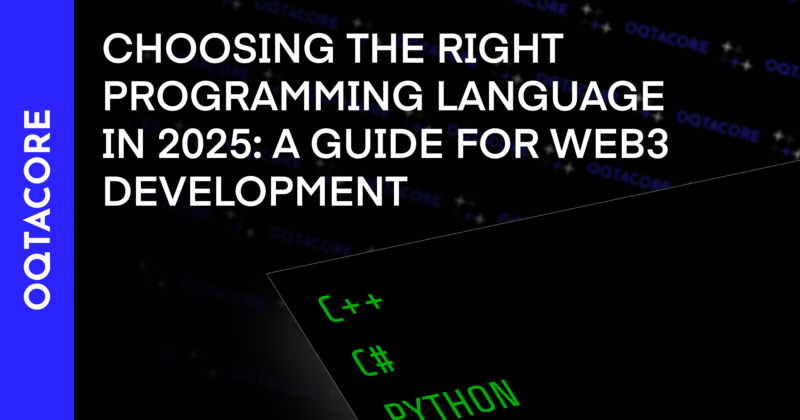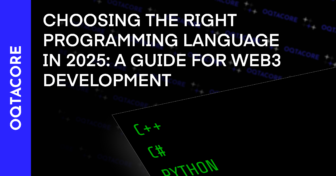
As we move further into 2025, the Web3 ecosystem continues to grow and evolve. One of the most critical decisions any Web3 project will face is choosing the right programming language. Whether you’re building a decentralized application (dApp), crypto exchange, or blockchain infrastructure, selecting the best language for your goals, performance requirements, and available resources is key to success.
In this guide, we’ll explore the most popular programming languages for Web3 development, examine the factors to consider when choosing a language, and discuss which options are most suitable for building scalable and secure Web3 applications.
Key Factors to Consider When Choosing a Programming Language
When selecting a programming language for your Web3 project in 2025, it’s essential to evaluate several key factors:
- Developer Availability: How many developers are proficient in the language? More widely used languages tend to have a larger talent pool.
- Developer Psychology: Developers often have preferences based on ease of use, community support, and available resources.
- Suitability for the Task: Some languages are better suited for specific tasks, such as smart contract development, blockchain protocols, or data analytics.
- Ecosystem: A rich ecosystem of libraries, frameworks, and community support can speed up development.
- Existing Codebase: Is there a wealth of reusable code available, such as on GitHub, to reduce development time?
- Frameworks and Libraries: The availability of pre-built frameworks or libraries can simplify complex tasks.
- Developer Pool Size: For large companies, the availability of developers proficient in a language is crucial to ensure scalability in staffing and support.
Popular Programming Languages for Web3 in 2025
Rust
- Creation Year: 2015
- Turing Complete: Yes
- Speed: High
- Concurrency: Yes
- Primary Use: Blockchain algorithms, smart contracts, performance-critical applications
- Why Choose Rust: Rust is becoming a go-to language for blockchain development due to its memory safety, high performance, and concurrency support. It is used for building secure, efficient blockchain protocols and is especially favored for Solana and other high-performance blockchain projects.
Benefits:- High performance and low resource consumption.
- Strong concurrency model for managing high-load systems.
Sui
- Creation Year: 2021
- Turing Complete: Yes
- Speed: High
- Concurrency: Yes
- Primary Use: Blockchain, smart contracts, decentralized finance (DeFi)
- Why Choose Sui: Built for smart contract execution and optimized for Web3 applications, Sui is a fast-growing choice for developers looking for a scalable, decentralized ecosystem.
Benefits:- Tailored for Web3 use cases.
- High scalability for blockchain networks.
Move
- Creation Year: 2021
- Turing Complete: Yes
- Speed: High
- Concurrency: Yes
- Primary Use: Blockchain smart contracts
- Why Choose Move: Move is designed specifically for blockchain smart contract development, focusing on security and performance. It’s used in Sui and other innovative blockchain ecosystems to write highly secure and efficient smart contracts.
Benefits:- Specialized for blockchain-based applications.
- High security for handling digital assets.
C++
- Creation Year: 1979
- Turing Complete: Yes
- Speed: Very High
- Concurrency: Yes
- Primary Use: Blockchain algorithms, computational tasks
- Why Choose C++: Known for its low-level system programming capabilities, C++ remains a critical language for blockchain development, especially for performance-heavy applications. It’s used for developing blockchain nodes, consensus algorithms, and performance-critical parts of blockchain systems.
Benefits:- Offers fine-grained control over system resources.
- Highly efficient for computation-heavy tasks.
JavaScript
- Creation Year: 1996
- Turing Complete: Yes
- Speed: Moderate
- Concurrency: Yes
- Primary Use: Web applications, backend systems, smart contracts
- Why Choose JavaScript: JavaScript is still the dominant language for Web3 front-end and backend development. Its versatility, coupled with frameworks like Node.js, makes it a perfect fit for both dApps and backend blockchain integration.
Benefits:- One language for both client-side and server-side development.
- Large community and ecosystem support.
TypeScript
- Creation Year: 2012
- Turing Complete: Yes
- Speed: Moderate
- Concurrency: Yes
- Primary Use: Web and blockchain apps
- Why Choose TypeScript: TypeScript is a superior version of JavaScript with added static typing that enhances code reliability and developer productivity. It’s widely used in Web3 for building large-scale applications, where type safety and code maintainability are crucial.
Benefits:- Better developer experience with strong typing.
- Seamless integration with JavaScript ecosystems.
Java
- Creation Year: 1996
- Turing Complete: Yes
- Speed: Moderate
- Concurrency: Yes
- Primary Use: Backend systems, enterprise-level applications
- Why Choose Java: Java has been the backbone of enterprise applications for decades, offering strong support for complex business logic, security, and database management. It’s commonly used in enterprise Web3 solutions.
Benefits:- Mature ecosystem and extensive libraries.
- Excellent for backend systems and complex workflows.
C#
- Creation Year: 1998
- Turing Complete: Yes
- Speed: High
- Concurrency: Yes
- Primary Use: Backend systems, AI, algorithms
- Why Choose C#: Known for its simplicity and efficiency, C# is ideal for enterprise backend development and is used extensively in blockchain projects requiring AI, machine learning, and data processing.
Benefits:- Clear syntax and robust tools for enterprise development.
- Efficient for backend integration with Web3 systems.
Python
- Creation Year: 1991
- Turing Complete: Yes
- Speed: Moderate
- Concurrency: Yes
- Primary Use: Data analysis, AI, backend systems
- Why Choose Python: Python’s widespread popularity in data analysis and AI makes it an essential tool in the Web3 space, especially for blockchain analytics, machine learning models, and data-driven applications.
Benefits:- Easy to learn and use, with a huge library support for AI and ML.
- Extensive community support in blockchain and data science.
Frameworks and Libraries for Web3 Development
React Native & Flutter for Hybrid Mobile Apps
For building cross-platform mobile apps, frameworks like React Native and Flutter enable developers to write code once and deploy on both iOS and Android. While React Native offers greater flexibility, Flutter provides superior performance and a more predictable user experience.
Truffle Suite & Hardhat for Smart Contract Development
For Ethereum and smart contract development, Truffle and Hardhat provide robust frameworks for writing, testing, and deploying contracts. These tools significantly reduce the complexity of working with blockchain networks.
Conclusion: Making the Right Choice in 2025
As Web3 technology continues to mature, choosing the right programming language and framework for your project is vital. Whether you’re building a blockchain node, smart contracts, or decentralized apps, each language offers unique advantages. Understanding the specific needs of your Web3 project – such as performance, scalability, and security – will help you select the optimal tech stack.
In 2025, languages like Rust and Sui are becoming increasingly important for blockchain development, while JavaScript and Python remain essential for dApps and data-driven applications. Whether you’re a startup or a large company, the right combination of languages and frameworks will ensure that your Web3 project is ready for the challenges of tomorrow.
Explore More About Web3 Technologies:
- 10 Essential Steps to Build Your Own Crypto Exchange
- Top 10 Best Blockchain Protocols in 2025
- Building High-Performance, Secure & Scalable DeFi Infrastructure
